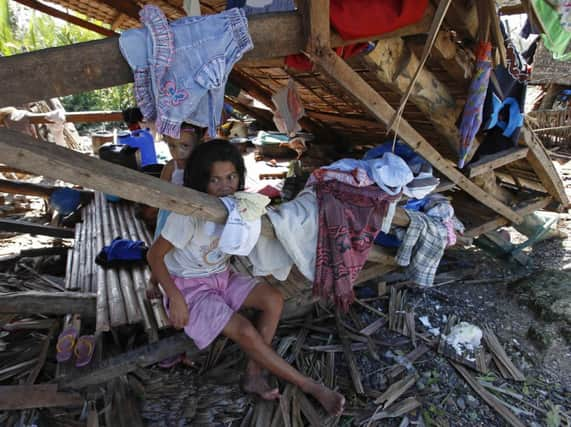Typhoon Hagupit: 21 dead in the Philippines


The sun peeked out over the central island provinces yesterday but Manila and nearby provinces were braced for high winds as Hagupit made landfall on the resort town of San Juan in Batangas province, about 60 miles south of the Philippine capital. It had maximum sustained winds of 53mph and gusts of around 62mph.
Although considerably weaker, the storm remained potentially dangerous and could still generate storm surges, forecasters said. More than 2,000 villagers sheltered in a public gymnasium as torrential rains pounded San Juan, a low-lying and flood-prone town.
Advertisement
Hide AdAdvertisement
Hide Ad“It’s really scary if you’ve watched what happened during Haiyan,” said Amy de Guzman, 43, a mother of three. “I hope the storm blows away from here as far as possible.”
While officials expressed relief that the typhoon had not caused major damage in Tacloban and other cities that were devastated by Haiyan, they warned that it was still on course to barrel into the southern tip of the main northern island of Luzon where Manila is located, before starting to move away today into the South China Sea.
Many of those in eastern areas who evacuated to shelters started to return home after the typhoon had passed, Philippine Red Cross secretary-general Gwendolyn Pang said.
Manila mayor Joseph Estrada said more than 5,000 residents of a shanty town on the edge of Manila Bay have been evacuated due to possible storm surges.
“We’ve prepared and trained for this,” said Mr Estrada adding his greatest fear was widespread flooding. Metropolitan Manila has a population of more than 12 million people. Like villagers in the central Philippines, Mr Estrada said Manila residents were readily moving to safety because of memories of Haiyan.
The strongest typhoon on record to hit land, Haiyan’s tsunami-like storm surges, levelled entire villages and left more than 7,300 people dead or missing in November last year.
Hagupit left at least 21 people dead, including 16 villagers who drowned in Eastern Samar province, where the typhoon made its first landfall, according to the Philippine Red Cross.
The government disaster-response agency has reported only five deaths, including three people who died of hypothermia, saying it was still verifying other reported casualties. Displaced villagers have been asked to return home from emergency shelters in provinces where the danger posed by the typhoon had waned, including Albay province, where more than half a million people were advised to leave evacuation sites.
Advertisement
Hide AdAdvertisement
Hide AdNearly 12,000 villagers, however, will remain in government shelters in Albay because their homes lie near a restive volcano.
Despite the relief that Hagupit had not been as devastating as was feared, a major operation remained to clear debris and get supplies to people left homeless or without power.
Proceso Alcala, the Philippine farming minister, said initial reports put crop and farm infrastructure damage at £14m, with rice crops most affected.